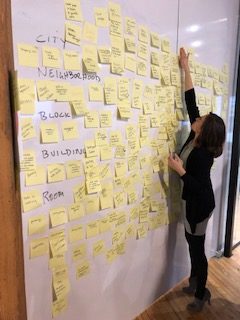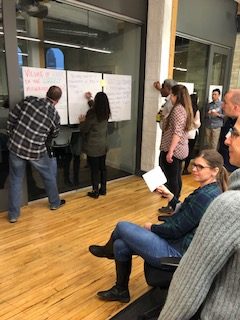See Math Everywhere

We had a record crowd for Collab Lab 27, where we explored ways to enable kids and parents find creative and playful ways to engage in math throughout Milwaukee. The focus for the session started with an idea Mary Langmyer raised coming out of our December Collab Lab– what would it look like if we could see math everywhere in Milwaukee? We worked with Mary to put together a vision statement, and started talking to folks we wanted to pull in to help figure this out.


Mary introduced the evening’s topic and several of her sources of inspiration. We then had attendees form groups that each contained a mix of educators and community partners. Their first task was a brainstorming activity to capture ideas what seeing math everywhere might look like.
Each group was then asked to pick an idea to develop. We had them flesh out details, get some feedback from other attendees, and then outline what it would take to move the idea forward. Here’s what the groups came up with.
Estimation on Location
A scavenger hunt to estimate distances, times, quantities, percents age, etc. of neighborhood landmarks.
- Where: School, library, neighborhood, grocery store, parks, pools
- Who: Teacher, librarian, community organization, leader, parents, students, pedestrians
- When: How about now? How many windows are in this building?
- Partners: Libraries, schools, neighborhood associations, businesses, MCTS
- Resources: Basics, like paper, volunteers, data, tracking, use a Google form or app if you want to get fancy.
- Testing it out: School, library, south shore park
Fort MKE
Engage neighborhoods in construction of forts from re-cycled material
- What: Everyone likes a fort; recycled/refurbished material; visual appeal of design; potential metrics– capacity, dimensions, quantity of material used, location coordinates
- Why: Build community locally and across the city; teach math and engineering design, and communication skills
- Where: Parks or schools– activate anywhere (access/equity)
- Who: Kids in Milwaukee; 3 levels, for elementary, middle, and high school students. High school students might take on as a service learning project for a homeless shelter
- When: Summer
- Prize: Top design becomes an interactive exhibit at Discovery World (with membership for participating kids and families?)
- Partners: MIAD, Rockwell, Northwestern Mutual, MSOE, Discovery World, Milwaukee County Parks, neighborhood associations
- Resources: Recycled building materials, marketing materials
- Funding: Sponsorship from partners
- Test: Pilot in fall of 2019 with 2 schools
Family Road Trip – Go With Math
Math related activities for families planning a road trip

- What: Budgeting of time and money – miles, maps, calculations
- pre planning/investigating multiple trips; ranking
- spreadsheet tracking
- estimation and comparison with actual outcome
- create simulation/game/scenarios of chance
- create an app for others
- environmental impact/cost
- Why: Apply math, critical thinking real life, dream, plus plan and budgeting for the unexpected
- Where: Could be anywhere!
- Who: Anyone, any age– a family activity
- When: Summer project with family or as project within school
- Partners: travel agent, gas stations, visit MKE, tourist attractions, restaurants, transit, banks
- Resources: Online travel planning ; spreadsheet app/program
- Funding: Donors choose/go fund me; online research sites for sustainability
Fitness App Hackathon
A STEM challenge for Milwaukee area students to develop a fitness app
- What: Hackathon to develop an app to track steps, heart rate, milage, weight goals; Once launched, users can hit fitness goals to unlock discounts at local establishments
- Who: Collaboration with MSOE and YMCA
- Where: Host the hackathon at MSOE
- Partners: MSOE, YMCA, MPS, Learn Deep, area accelerators; MKE retailers and vendors
- Resources: CYSI; local incubators; Vroom; MSOE students/faculty; YES! (Young Enterprising Society)
What does it take to dye the Milwaukee river?
What’s the math around dying the Milwaukee river green?

- What: On the (now past) occasion of dying the Milwaukee river green, have students estimate how much dye is actually required.
- Why: Apply concepts of volume, concentration, and flow rate to a real-life problem
- Where: Competition at the Fiserv Forum where teams present their calculations. Winning team gets to participate in the ceremony to dye the river.
- Who: MPS middle and high school students
- When: NBA Playoffs for 2020?
- Partners: Bucks, City of Milwaukee, DNR, Brewers, DNC, local universities
- Resources: River measurement estimates (with which to calculate volume; data on dye concentration levels/coverage
- Funding: Sponsors to fund Fiserv event; food & beverage donations
- Test: Get the data from 2019 event; model the problem in a classroom to calculate volume and use food coloring to estimate concentration levels
Milwaukee’s Movable Bridges
Math explorations while waiting for a bridge to lower

- Where: Milwaukee River bridges along Plankinton Avenue and Water Street
- What: Younger kids – count the number of boats going past; older kids — geometry of bridges (height, angle when raised, shape), velocity, duration of events — boats passing, bridge raising/lowering; how can this process be made more efficient for everyone impacted?
- When: Anytime, or while waiting for a bridge
- Why: We have a captive audience that needs to do something during the wait time.
- Who: Drivers, walkers, bikers, public transit riders, boaters
- When: Spring/Summer (to supplement summer learning)
- Partners: Milwaukee Public Works, Vroom, Google field trips
- Resources: Signage by bridges
- Funding: City, summer/after school programs
- Test: social media challenge; summer to do list from school
Math-a-thon
Math races for a cause
- What: Create a math race for your favorite cause where participants look at
- estimation
- measurement
- conversions
- functions
- substitution
- geometry – angles, slopes
- speed/velocity
- rate of change
- averages
- variables
- Why: See math everywhere– Students determine purpose and type of race (bike, walk, marathon)
- Where: Milwaukee area with evidence of math and interest (animals, vets, immigration, etc.)
- Who: 6th-12th grades
- When: Winter/spring of 2020
- Partners: City (route feedback, viability); Existing races/walks; fundraisers, organizers, MPS
- Resources: Classrooms/teachers
- Funding: Contest, racing funding
- Test: Plan southside mural tour with 3rd-5th graders for winter of 2019. Show results to potential partner organizations to sponsor an event during the summer of 2020
Smoothies for Mathies
Play with ratios by playing with food
- What: Smoothie cards that are placed next to ingredients within grocery stores with activities focused on cost, nutrition, and quantities.
- Substitutions, pie charts, percentages
- Include prompts for families — what is the most cost effective, nutritious, etc.
- Why: Access– we all eat, practical knowledge, adaptable recipe, nutrition, creativity, trying new foods/combinations
- Where: Grocery stores, fruit stands, farmers’ markets, gas stations, anywhere food is sold
- Who: Shoppers, stores– could be categorized by goal, e.g. more fiber, ethnic food, weight loss, body building
- When: anytime/seasonal recipes

- Partners: Aldi, Sendiks, Outpost, Pic N Save, other local stores, Fondy food center, Riverwest Community Food Center
- Resources: Nutritionist, cook book authors, chefs, graphic designers, MIAD, printers, distribution/display maintenance
- Funding: grants, advertising/promotion, brands pay for printing, food entrepreneurs for product placement; UW extension, WIC community outreach.
- Test: individual store, easy to duplicate if successful; community stores
If you want to bake a pizza you must first invent the universe
An after school program to grow and prepare food
- When: After school
- Where: Neighborhood center
- Why: People eat every day. If you are seeing math in something you do everyday, you’re learning math (in addition to nutrition and health)
- Who: Students
- Elementary School – garden
- Middle School – Grocery store
- High School – Test kitchen
- How: Chez Panisse in Berkeley, grants, neighborhood center, partner
- Partners: Grocery store, farm, restaurant, CSA school PTO, neighborhood center, Discovery World,
Build a Business
Student run business as exposure for applied math
- What: Understanding economics of building a business; competition w/startup funding and showcase of ideas.
- Why: Teach students fundamental math skills used in a business
- pricing
- costs
- strategies
- marketing, etc.
- Where: After school program
- Who: Middle and high school students
- When: During school (equity); after school
- Partners: Banks, JA, area entrepreneurs, foundations, sporting teams
- Barriers: Time, funding for startups, curriculum, scalability
- Resources: Leighton (MPS Rec), interested teachers/school districts, Universities, business schools, B-school students
- Testing: 1-2 MPS After School summer programs/CLC site
Thanks!
Thanks again to Mary Langmyer for her enthusiasm and work to pull the session together, and The Commons for providing the space for this month’s Collab Lab. Thanks also to Monique Liston from Ubuntu Research who brought her grad students to both lend a hand and participate in the session.
For those of you that want to connect with or learn more about some of the math folks and resources from the Collab Lab:
Mary Langmyer is on Twitter @mlangmyer
Chris Nho with Chicago Public Schools and Public Math is on Twitter @nhoskee
Synovia Moss at Medical College of Wisconsin coordinates Vroom for our area
Gabriella Pinter at UWM runs math circles for teachers and students

